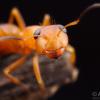(first post!) This is my first time ever raising a P. Imparis colony! I caught six queens in total from April 6-7. I put four queens in one tube, and two queens in another. People generally either say they're super easy to keep, or they're very difficult to keep alive. Both colonies have brood, my two queen colony has a pile of what looks like either first instar larvae or eggs. My four queen colony has a small pile and some scattered brood, and I don't remember seeing any larvae. All of the queens have shed their wings, except for one in the four queen colony who I'm worried might be infertile or uncooperative with the other queens, because I tend to see her biting at the cotton leading out of the tube. This could be from stress though. I've had a problem of constantly checking on them daily, and I'm concerned the four queen colony might have eaten some of their eggs. I put tin foil around both of their tubes, stuck them in my ant drawer, and won't be checking on them until next month. I've talked to several other ant keepers, and some say they're developing very quickly (usually they don't start laying eggs until summer, and others say there could be a problem. When can I expect workers, and what should I do to specialize their care? I've always wanted a colony of these guys and I want to make sure I'm doing everything right! ![]()
Sorry for the bad photo, took this on my phone. I enhanced it to make the queens and eggs look more visible! I don't have any photos of the two queen colony ![]()
https://lh3.googleus.../2020-05-06.jpg
here's the photo ![]()
EDIT: I will be making a journal for these guys! Turns out none of them have any first instar larvae, just some large eggs!
Edited by jushi, May 9 2020 - 10:58 AM.


















